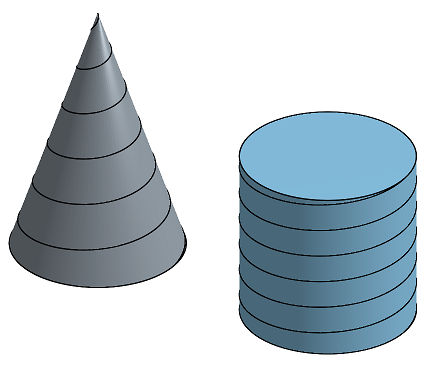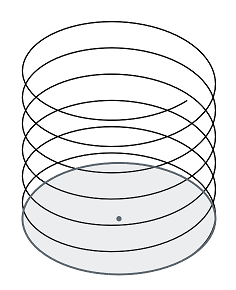 Helix
Helix
![]()
![]()
![]()
Create a helix using a conical or cylindrical face, single axis or z-axis of a Mate connector, or circular edge.
A helix may be used for sweeps (to create a simple spring). A helix does not consume the part used to create it.
This video explains how to create a helix around a cylinder or cone. In this example, a cylinder is created in the graphics area.
Click the Helix feature tool on the toolbar. Select Cylinder/Cone for the Helix type. Select the cylinder in the graphics area.
Select the Input type on which to base the helix: Turns, Pitch, or Turns and pitch. Click the Opposite direction arrow to flip the helix direction.
Select the start condition. Start angle begins the helix from a reference point on the cylinder or cone; this is the start of the revolve or the x-axis of an extruded circle. Start point begins the helix from a vertex on the circular edge of the cylinder or reference geometry.
If the Input type selected is Turns or Pitch, select either height, which limits the height of the helix to the height of the cylindrical face, or End point, which limits the height of the helix to a selected vertex on the cylinder or reference geometry.
When End point is selected, a Computed revolutions field displays the rounding used. By default, revolutions are rounded down. Click the Flip rounding arrow to instead round revolutions up.
If Input type is Turns or Turns and pitch, specify the amount of helix revolutions in the Revolutions field. If the Input type is Pitch, specify the Target pitch. This is the dimension of the helical pitch (the distance traveled axially in each revolution).
Specify turn direction, either Clockwise or Counterclockwise.
Optionally, select Show start and end profiles to highlight the profiles in the graphics area.
Click the checkmark to accept the new helix.
- With a cone or cylinder sketch in the graphics area, click
 .
.
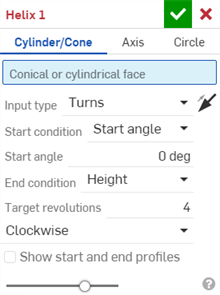
- Select Cylinder/Cone for the helix path type, if it is not already selected.
- Select a conical or cylindrical face in the graphics area.
-
Select the Input type on which to base the helix: Turns, Pitch, or Turns and pitch. Click the Opposite direction arrow
 to flip the direction of the helix.
to flip the direction of the helix.
- Select the Start condition:
Start angle - The measurement from a reference point on the cylinder or cone; the start of the revolve or the x-axis of an extruded circle (in preferred units)
Start point - A vertex on the circular edge of the reference geometry for the cylinder or cone.
- If the Input type selected is
Turns
or
Pitch, select one of the following End conditions:
- Height - Height of the helix on the conical or cylindrical face (you can also use the drag manipulator)
- End point
- A vertex on the construction geometry's circular edge. When selected, a Computed revolutions field opens. Optionally click the Flip rounding arrow
 to round the computed revolutions up.
to round the computed revolutions up.
- Specify one of the following:
- Target revolutions - Available if Input type is Turns or Turns and pitch, this is the number of helix revolutions.
- Target pitch - Available if the Input type is Pitch, this is the dimension of the helical pitch (distance traveled axially in each revolution).
- Specify the direction of the turns: Clockwise or Counterclockwise.
- Optionally select Show start and end profiles to highlight the profiles in the graphics area.
-
Click
 .
.
This video explains how to create a helix around an axis or a Mate connector's z-axis. In this example, there is a square sketch on the Top plane, a line on the Front plane, and a cube with a Mate connector on one of its sides.
Click the Helix feature tool on the toolbar. Select Axis for the Helix type.
Select the axis around which the helix is created. In this example, select the line. Alternatively, you can select a Mate connector to use its z-axis around which the helix is created.
Select the Input type on which to base the helix: Turns, Pitch, or Turns and pitch. Click the Opposite direction arrow to flip the helix direction.
Select the start condition. Start angle begins the helix from a reference point on the axis; this is the start of the revolve. Enter a radius for the helix. Alternatively, select a Start point to begin the helix from a vertex on the edge of the axis or reference geometry. Click the Opposite direction arrow to use the opposite vertex as the helix start point.
Click the End radius checkbox and select the end radius for the helix. If the Input type selected is Turns or Pitch, select Height or End point. If Height is selected, enter a height value or drag the manipulator in the graphics area. If End point is selected, select a vertex on the reference geometry to end the helix at that point.
When End point is selected, a Computed revolutions field displays the rounding used. By default, revolutions are rounded down. Click the Flip rounding arrow to instead round revolutions up.
If Input type is Turns or Turns and pitch, specify the amount of helix revolutions in the Revolutions field. If the Input type is Pitch, specify the Target pitch. This is the dimension of the helical pitch (the distance traveled axially in each revolution).
Specify turn direction, either Clockwise or Counterclockwise.
Optionally, select Show start and end profiles to highlight the profiles in the graphics area.
Click the checkmark to accept the new helix.
- With the axis object sketch in the graphics area, click
 .
.
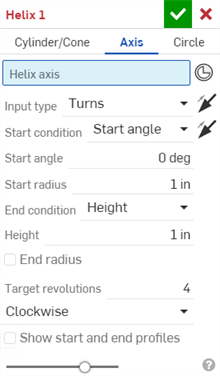
- Select Axis for the helix path type.
- Select one of the following:
- A Helix axis (for example, a line or edge), to create a helix oriented along its axis.
-
An existing Mate connector, to create a helix oriented on its Z-axis. If one does not exist, click the Mate connector icon
 to create a new implicit Mate connector.
to create a new implicit Mate connector.
-
Select the Input type on which to base the helix: Turns, Pitch, or Turns and pitch. Click the Opposite direction arrow
 to flip the direction of the helix.
to flip the direction of the helix.
- Select the Start condition, and optionally click the Opposite origin arrow
 to use the opposite vertex as the helix start point:
to use the opposite vertex as the helix start point:
- Start angle - The measurement from a reference point on the axis; the start of the revolve (in preferred units).
- Start point - A vertex on the axis.
- Enter the Start Radius (in preferred units), the radius about the axis.
- If the Input type selected is
Turns
or
Pitch, select one of the following End conditions:
- Height - Height of the helix. Enter the Height in preferred units or use the drag manipulator.
- End point
- A vertex on the axis edge. When selected, a Computed revolutions field opens. Optionally click the Flip rounding arrow
 to round the computed revolutions up.
to round the computed revolutions up.
- Optionally, check End radius, and enter an End radius in preferred units. Using a different start and end radius creates a non-symmetrical helix.
- Specify one of the following:
- Target revolutions - Available if Input type is Turns or Turns and pitch, this is the number of helix revolutions.
- Target pitch - Available if the Input type is Pitch, this is the dimension of the helical pitch (distance traveled axially in each revolution).
- Specify the direction of the turns, Clockwise or Counterclockwise.
- Optionally select Show start and end profiles to highlight the profiles in the graphics area.
-
Click
 .
.
This video explains how to create a helix around a circle.
Click the Helix feature tool on the toolbar. Select Circle for the Helix type.
Select a circle sketch in the graphics area to form the helix around the circle.
Select the Input type on which to base the helix: Turns, Pitch, or Turns and pitch. Click the Opposite direction arrow to flip the helix direction.
Select the start condition. Start angle begins the helix from a reference point on the circle; this is the start of the revolve. Alternatively, select a Start point to begin the helix from a vertex on the edge of the circle or reference geometry.
If the Input type selected is Turns or Pitch, select Height or End point. If Height is selected, enter a height value or drag the manipulator in the graphics area. If End point is selected, select a vertex on the reference geometry to end the helix at that point.
When End point is selected, a Computed revolutions field displays the rounding used. By default, revolutions are rounded down. Click the Flip rounding arrow to instead round revolutions up.
If Input type is Turns or Turns and pitch, specify the amount of helix revolutions in the Revolutions field. If the Input type is Pitch, specify the Target pitch. This is the dimension of the helical pitch (the distance traveled axially in each revolution).
Specify turn direction, either Clockwise or Counterclockwise.
Optionally, select Show start and end profiles to highlight the profiles in the graphics area.
Click the checkmark to accept the new helix.
- With a circle sketch in the graphics area, click
 .
.
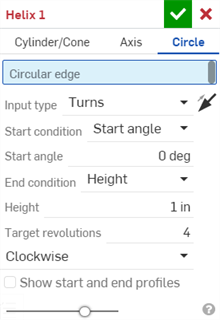
- Select Circle for the helix path type.
- Select a Circular edge (circle or arc) in the graphics area. The circumference of the circle or arc forms the base of the helix.
-
Select the Input type on which to base the helix: Turns, Pitch, or Turns and pitch. Click the Opposite direction arrow
 to flip the direction of the helix.
to flip the direction of the helix.
- Select the Start condition:
- Start angle - The measurement from a reference point on the circular edge; the start of the revolve or the x-axis of the circle (in preferred units)
- Start point - A vertex on the circular edge.
- If the Input type selected is
Turns
or
Pitch, select one of the following End conditions:
- Height - Height of the helix. Enter the Height in preferred units or use the drag manipulator.
- End point
- A vertex on any other construction geometry. When selected, a Computed revolutions field opens. Optionally click the Flip rounding arrow
 to round the computed revolutions up.
to round the computed revolutions up.
- Specify one of the following:
- Target revolutions - Available if Input type is Turns or Turns and pitch, this is the number of helix revolutions.
- Target pitch - Available if the Input type is Pitch, this is the dimension of the helical pitch (distance traveled axially in each revolution).
- Specify the direction of the turns, Clockwise or Counterclockwise.
- Optionally select Show start and end profiles to highlight the profiles in the graphics area.
-
Click
 .
.
Using an End point vertex on the same plane as the circle creates a helix without any height.
Cylinder/Cone
In the left example, the cylindrical face (Face of Extrude 1) is the base about which the helix is oriented. In the right example, the conical face (Face of Loft 1) is the base about which the helix is oriented:
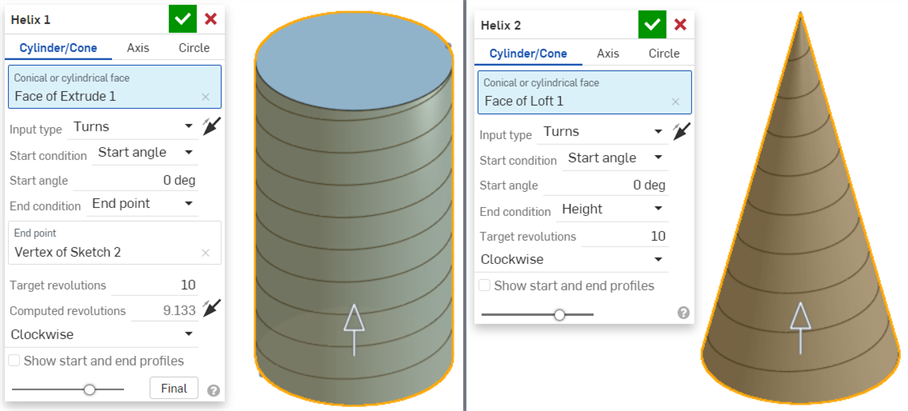
Axis
In the following example, two circles are sketched vertically on two planes. Each sketch also has a point along the edge of the circle. The edge of the circle on the Top plane (Edge of Sketch 1) is the Axis object about which the helix is oriented. The point on Sketch 1 (outlined in orange) is used for the helix Start point, and the point on Sketch 2 (outlined in yellow) is used for the helix end point:
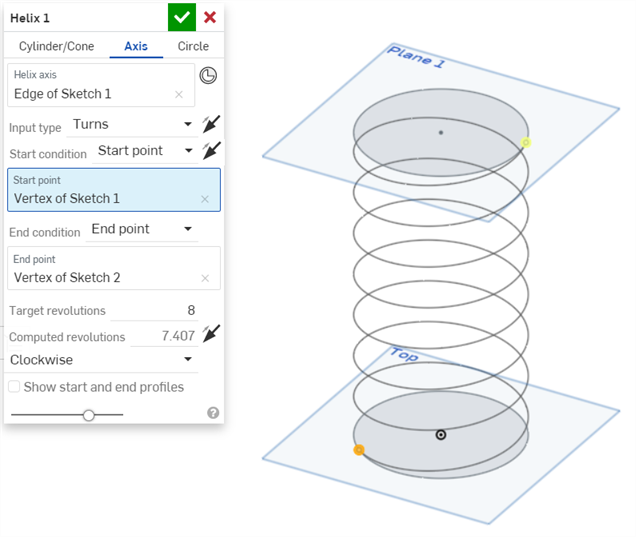
In the following example, a square is sketched on the Top plane, and a line is sketched on the Front plane. The line (Edge of Sketch 2) is the Axis object about which the helix is oriented. The Vertex of Sketch 2 (at the top of the line) is used for the helix Start point, and the corner of the square (Vertex of Sketch 1; outlined in yellow) is used for the helix end point:
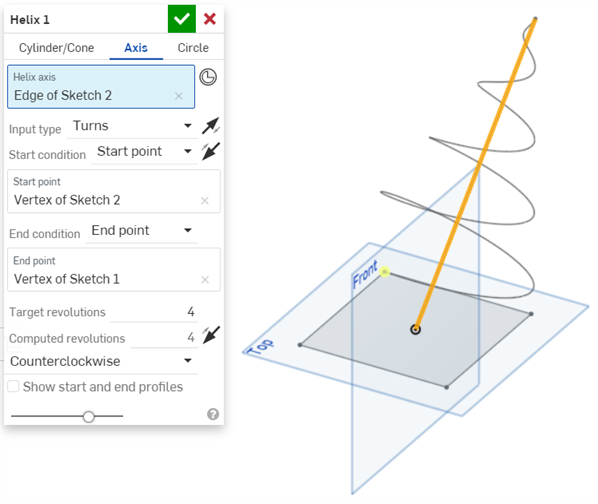
In the following example, the helix is created on a single plane. A circle sketch (Edge of Sketch 6) is the Axis object about which the helix is oriented. The point on the outer edge of the circle (Vertex of Sketch 6; in yellow) is used for the helix Start point, and the point in the middle of the circle (Vertex of Sketch 6; in orange) is used for the helix End point:
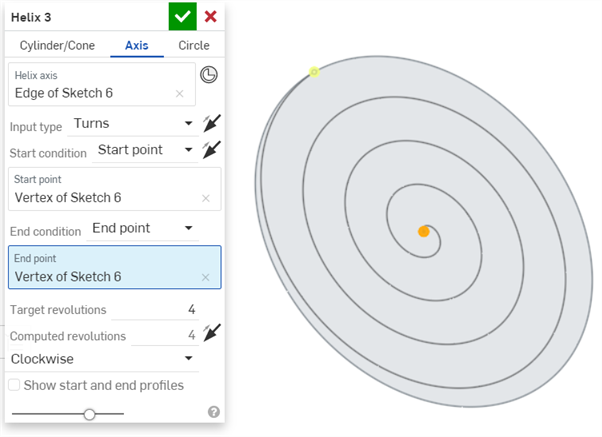
Circle
In the following example, the edge of the circle sketch (Edge of Sketch 1) is the circular edge forming the base of the helix (outlined in orange):
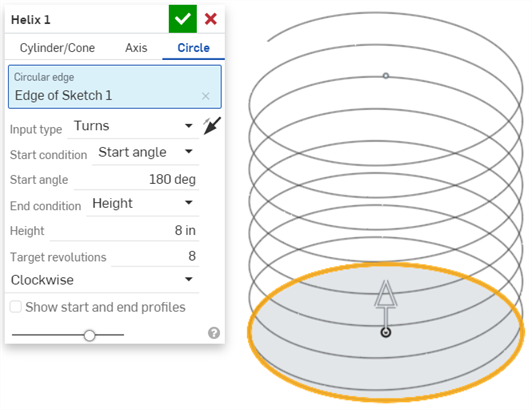
In the following example, the same circle edge as above forms the base of the helix (outlined in yellow). A point from another sketch on a vertical plane (Vertex of Sketch 2) is used for the helix End point:
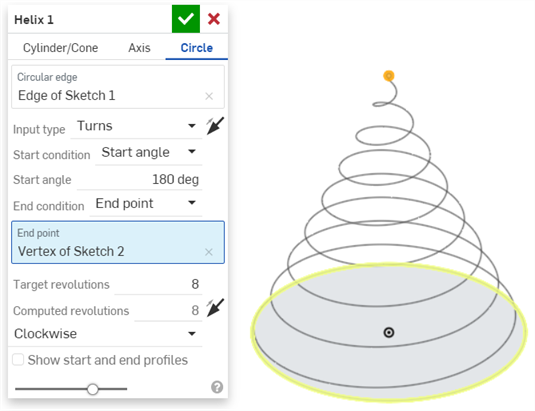
Creating a spring
- Create a helix around a cylinder or cone, as described above:
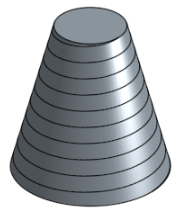
- Create a curve point plane using the helix and the vertex of the helix:
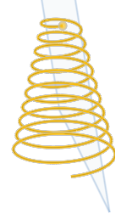
- Sketch a circle on the plane, using (
 ) the helix vertex for the center of the circle:
) the helix vertex for the center of the circle:
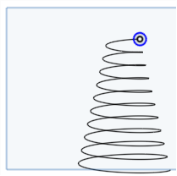
- Sweep the circle along the helix (path):
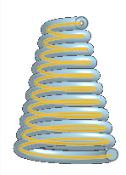
- Click
 .
.
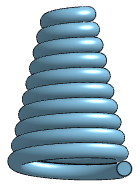
If it helps, you can hide the cone or cylinder (use the
![]() in the Parts list).
in the Parts list).
The plane in the image above is a new plane, intersecting the helix vertex and normal to the edge of the helix.
In addition to the surfacing tools, curves are used to create the basic building blocks of surfaces.
This lists the collection of curve feature tools. This is not an exhaustive list. Additional Feature tools may be used when manipulating curves.
- Sketch tools - Tools in the Sketch toolbar such as Line, Corner rectangle, Center point rectangle, Center point circle, 3 point circle, Tangent arc, 3 point arc, Spline, Point, and Construction used to create a sketch in a Part Studio.
-
 Helix - Create a helix using a conical or cylindrical face, single axis or z-axis of a mate connector, or circular edge.
Helix - Create a helix using a conical or cylindrical face, single axis or z-axis of a mate connector, or circular edge. -
 3D fit spline - Create a 3D fit spline through a series of vertices. Creates a curve which is listed in the Parts list under Curves.
3D fit spline - Create a 3D fit spline through a series of vertices. Creates a curve which is listed in the Parts list under Curves. -
 Projected curve - Create a curve from the projection of two sketches (Two sketches option) or from the projection of a curve on a face (Curve to face option).
Projected curve - Create a curve from the projection of two sketches (Two sketches option) or from the projection of a curve on a face (Curve to face option). -
 Bridging curve - Create a Curve connecting any two points, vertices, or Mate connectors. The resulting Curve is listed in the Feature list and the Parts list.
Bridging curve - Create a Curve connecting any two points, vertices, or Mate connectors. The resulting Curve is listed in the Feature list and the Parts list. -
 Composite curve - Represent multiple edges as one Curve. Select multiple adjacent edges, sketch entities, and other curves. Selecting non-contiguous edges may result in multiple Curves created. Selections for each Curve must meet at their vertices. (Curves are listed in the Parts > Curves list.)
Composite curve - Represent multiple edges as one Curve. Select multiple adjacent edges, sketch entities, and other curves. Selecting non-contiguous edges may result in multiple Curves created. Selections for each Curve must meet at their vertices. (Curves are listed in the Parts > Curves list.) -
 Intersection curve - Create a curve at the intersection of two or more surfaces or faces. The selections must intersect.
Intersection curve - Create a curve at the intersection of two or more surfaces or faces. The selections must intersect. -
 Trim curve - Trim or extend a curve by a distance or to a bounding entity.
Trim curve - Trim or extend a curve by a distance or to a bounding entity. -
 Isocline - Create an isocline on a sloped face. An isocline runs on a face at positions where the face has a certain slope compared to its reference definition. The resulting isocline is listed in the Feature list and Parts list.
Isocline - Create an isocline on a sloped face. An isocline runs on a face at positions where the face has a certain slope compared to its reference definition. The resulting isocline is listed in the Feature list and Parts list. -
 Offset curve - Create and extend and/or split a new curve by offsetting edges on surrounding faces.
Offset curve - Create and extend and/or split a new curve by offsetting edges on surrounding faces. -
 Isoparametric curve - Create smooth curves that run along a face or surface in the U or V direction.
Isoparametric curve - Create smooth curves that run along a face or surface in the U or V direction. -
 Edit curve - Edit an existing curve by selecting sketch entities or curves to apply a simplified approximation, elevate the degree, reposition control curve vertices and/or planarize into any 2D plane.
Edit curve - Edit an existing curve by selecting sketch entities or curves to apply a simplified approximation, elevate the degree, reposition control curve vertices and/or planarize into any 2D plane. -
 Routing curve - Create a multi-point curve across one or more planes in 3D space (routed path). This is useful for creating pipe routing, wiring, and NURBS curves for advanced surfacing.
Routing curve - Create a multi-point curve across one or more planes in 3D space (routed path). This is useful for creating pipe routing, wiring, and NURBS curves for advanced surfacing.
- Tap the Helix tool icon (
 ).
).
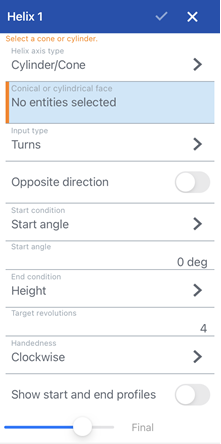
- Select Cylinder/Cone for the helix path type, if it is not already selected.
- Select a conical or cylindrical face in the graphics area.
-
Select the Input type on which to base the helix: Turns, Pitch, or Turns and pitch. Click the Opposite direction arrow
 to flip the direction of the helix.
to flip the direction of the helix.
- Select the Start condition:
Start angle - The measurement from a reference point on the cylinder or cone; the start of the revolve or the x-axis of an extruded circle (in preferred units)
Start point - A vertex on the circular edge of the reference geometry for the cylinder or cone.
- If the Input type selected is
Turns
or
Pitch, select one of the following End conditions:
- Height - Height of the helix on the conical or cylindrical face (you can also use the drag manipulator)
- End point
- A vertex on the construction geometry's circular edge. When selected, a Computed revolutions field opens. Optionally click the Flip rounding arrow
 to round the computed revolutions up.
to round the computed revolutions up.
- Specify one of the following:
- Target revolutions - Available if Input type is Turns or Turns and pitch, this is the number of helix revolutions.
- Target pitch - Available if the Input type is Pitch, this is the dimension of the helical pitch (distance traveled axially in each revolution).
- Specify the direction of the turns, Clockwise or Counterclockwise.
- Optionally select Show start and end profiles to highlight the profiles in the graphics area.
- Tap the checkmark.
- Tap the Helix tool icon (
 ).
).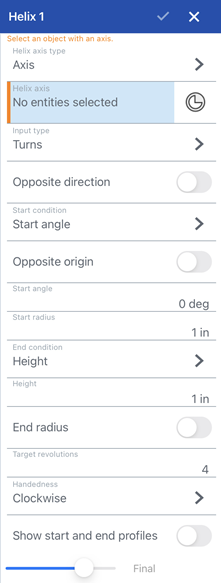
- Select Axis for the helix path type.
- Select the Helix axis (for example, a line or edge), to create a helix oriented along its axis.
- Optionally, tap the Mate connector icon to select or create implicit Mate connectors.
-
Select the Input type on which to base the helix: Turns, Pitch, or Turns and pitch. Click the Opposite direction arrow
 to flip the direction of the helix.
to flip the direction of the helix.
-
Select the Start condition, and optionally tap the Opposite origin arrow
 to use the opposite vertex as the helix start point:
to use the opposite vertex as the helix start point:
- Start angle - The measurement from a reference point on the axis; the start of the revolve (in preferred units).
- Start point - A vertex on the axis.
- Enter the Start Radius (in preferred units), the radius about the axis.
- If the Input type selected is
Turns
or
Pitch, select one of the following End conditions:
- Height - Height of the helix. Enter the Height in preferred units or use the drag manipulator.
- End point
- A vertex on the axis edge. When selected, a Computed revolutions field opens. Optionally click the Flip rounding arrow
 to round the computed revolutions up.
to round the computed revolutions up.
- Optionally, check End radius, and enter an End radius in preferred units. Using a different start and end radius creates a non-symmetrical helix.
- Specify one of the following:
- Target revolutions - Available if Input type is Turns or Turns and pitch, this is the number of helix revolutions.
- Target pitch - Available if the Input type is Pitch, this is the dimension of the helical pitch (distance traveled axially in each revolution).
- Specify the direction of the turns, Clockwise or Counterclockwise.
- Optionally select Show start and end profiles to highlight the profiles in the graphics area.
- Tap the checkmark.
- Tap the Helix tool icon (
 ).
).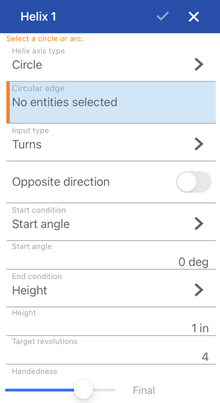
- Select Circle for the helix path type.
- Select a Circular edge (circle or arc) in the graphics area. The circumference of the circle or arc forms the base of the helix.
-
Select the Input type on which to base the helix: Turns, Pitch, or Turns and pitch. Click the Opposite direction arrow
 to flip the direction of the helix.
to flip the direction of the helix.
- Select the Start condition:
- Start angle - The measurement from a reference point on the circular edge; the start of the revolve or the x-axis of the circle (in preferred units)
- Start point - A vertex on the circular edge.
- If the Input type selected is
Turns
or
Pitch, select one of the following End conditions:
- Height - Height of the helix. Enter the Height in preferred units or use the drag manipulator.
- End point
- A vertex on any other construction geometry. When selected, a Computed revolutions field opens. Optionally click the Flip rounding arrow
 to round the computed revolutions up.
to round the computed revolutions up.
- Specify one of the following:
- Target revolutions - Available if Input type is Turns or Turns and pitch, this is the number of helix revolutions.
- Target pitch - Available if the Input type is Pitch, this is the dimension of the helical pitch (distance traveled axially in each revolution).
- Specify the direction of the turns, Clockwise or Counterclockwise.
- Optionally select Show start and end profiles to highlight the profiles in the graphics area.
- Tap the checkmark.
Using an End point vertex on the same plane as the circle creates a helix without any height.
- Create a helix from either a conical or cylindrical face or a circular edge, as described above.
If you used a cone or cylinder to make the helix, it helps to hide it. Do so with the hide icon in the feature list.
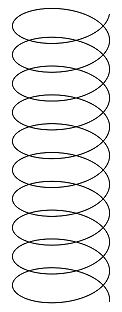
- With the Plane tool, create a plane using the plane type
Plane Point. Select a plane and select a point from either end of the helix.
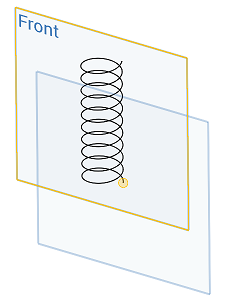
- On the new plane, sketch a circle around the point of the helix.
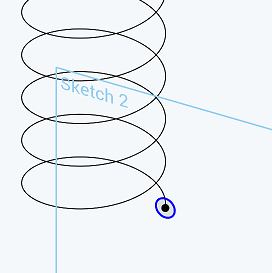
- Sweep the circle as a solid, using the helix as the sweep path.
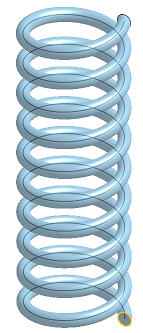
- Tap the checkmark.
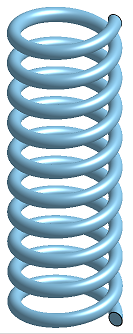
- Tap the Helix tool.

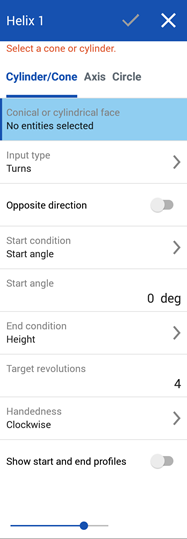
- Select Cylinder/Cone for the helix path type, if it is not already selected.
-
Select the Input type on which to base the helix: Turns, Pitch, or Turns and pitch. Click the Opposite direction arrow
 to flip the direction of the helix.
to flip the direction of the helix.
- Select the Start condition:
Start angle - The measurement from a reference point on the cylinder or cone; the start of the revolve or the x-axis of an extruded circle (in preferred units)
Start point - A vertex on the circular edge of the reference geometry for the cylinder or cone.
- If the Input type selected is
Turns
or
Pitch, select one of the following End conditions:
- Height - Height of the helix on the conical or cylindrical face (you can also use the drag manipulator)
- End point
- A vertex on the construction geometry's circular edge. When selected, a Computed revolutions field opens. Optionally click the Flip rounding arrow
 to round the computed revolutions up.
to round the computed revolutions up.
- Specify one of the following:
- Target revolutions - Available if Input type is Turns or Turns and pitch, this is the number of helix revolutions.
- Target pitch - Available if the Input type is Pitch, this is the dimension of the helical pitch (distance traveled axially in each revolution).
- Specify the direction of the turns, Clockwise or Counterclockwise.
- Optionally select Show start and end profiles to highlight the profiles in the graphics area.
- Tap the checkmark.
- Tap the Helix tool.


- Select Axis for the helix path type.
- Select the Helix axis (for example, a line or edge), to create a helix oriented along its axis.
-
Select the Input type on which to base the helix: Turns, Pitch, or Turns and pitch. Click the Opposite direction arrow
 to flip the direction of the helix.
to flip the direction of the helix.
-
Select the Start condition, and optionally tap the Opposite origin arrow
 to use the opposite vertex as the helix start point:
to use the opposite vertex as the helix start point:
- Start angle - The measurement from a reference point on the axis; the start of the revolve (in preferred units).
- Start point - A vertex on the axis.
- Enter the Start Radius (in preferred units), the radius about the axis.
- If the Input type selected is
Turns
or
Pitch, select one of the following End conditions:
- Height - Height of the helix. Enter the Height in preferred units or use the drag manipulator.
- End point
- A vertex on the axis edge. When selected, a Computed revolutions field opens. Optionally click the Flip rounding arrow
 to round the computed revolutions up.
to round the computed revolutions up.
- Optionally, check End radius, and enter an End radius in preferred units. Using a different start and end radius creates a non-symmetrical helix.
- Specify one of the following:
- Target revolutions - Available if Input type is Turns or Turns and pitch, this is the number of helix revolutions.
- Target pitch - Available if the Input type is Pitch, this is the dimension of the helical pitch (distance traveled axially in each revolution).
- Specify the direction of the turns, Clockwise or Counterclockwise.
- Optionally select Show start and end profiles to highlight the profiles in the graphics area.
- Tap the checkmark.
- Tap the Helix tool.

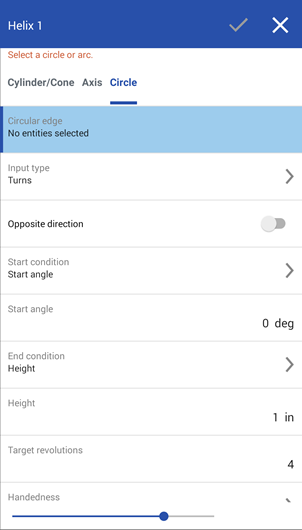
- Select Circle for the helix path type.
- Select a Circular edge (circle or arc) in the graphics area. The circumference of the circle or arc forms the base of the helix.
- Select the Start condition:
- Start angle - The measurement from a reference point on the circular edge; the start of the revolve or the x-axis of the circle (in preferred units)
- Start point - A vertex on the circular edge.
- Select the Start angle, the measurement from a reference point on the circular edge; the start of the revolve or the x-axis of the circle (in preferred units), or the Start point, a vertex on the circular edge.
- If the Input type selected is
Turns
or
Pitch, select one of the following End conditions:
- Height - Height of the helix. Enter the Height in preferred units or use the drag manipulator.
- End point
- A vertex on any other construction geometry. When selected, a Computed revolutions field opens. Optionally click the Flip rounding arrow
 to round the computed revolutions up.
to round the computed revolutions up.
- Specify one of the following:
- Target revolutions - Available if Input type is Turns or Turns and pitch, this is the number of helix revolutions.
- Target pitch - Available if the Input type is Pitch, this is the dimension of the helical pitch (distance traveled axially in each revolution).
- Specify the direction of the turns, Clockwise or Counterclockwise.
- Optionally select Show start and end profiles to highlight the profiles in the graphics area.
- Tap the checkmark.
Using an End point vertex on the same plane as the circle creates a helix without any height.
- Create a helix from either a conical or cylindrical face or a circular edge, as described above.
If you used a cone or cylinder to make the helix, it helps to hide it. Do so with the hide icon in the feature list.

- With the Plane tool, create a plane using the plane type
Plane Point. Select a plane and select a point from either end of the helix.

- On the new plane, sketch a circle around the point of the helix.

- Sweep the circle as a solid, using the helix as the sweep path.

- Tap the checkmark.

